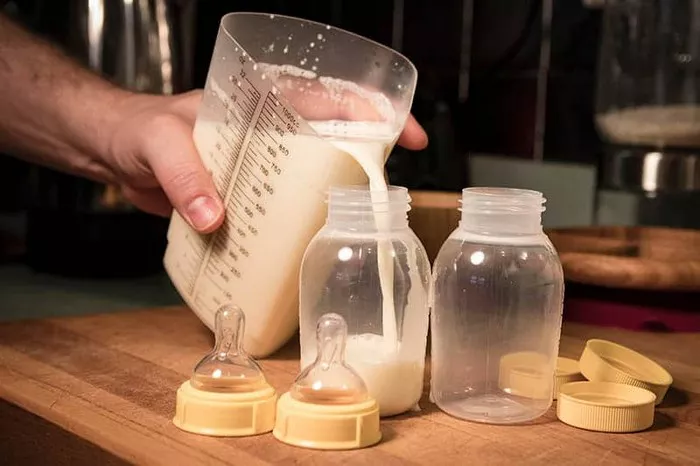For many new parents, the decision between breastfeeding and formula feeding can be a challenging one. While breastfeeding is often touted as the best option for infant nutrition, there are circumstances where formula feeding becomes necessary or preferred. In some cases, parents may even choose to combine both breast milk and formula to meet their baby’s nutritional needs. However, questions arise about the safety and effectiveness of mixing these two types of milk and storing them in the fridge. In this article, we will explore this topic in detail, addressing concerns and providing guidance for parents who may be considering this approach.
Understanding Breast Milk and Formula:
Before delving into the topic of mixing breast milk and formula, it’s essential to understand the composition of each. Breast milk is a complex fluid that provides optimal nutrition for infants. It contains a balanced blend of proteins, fats, carbohydrates, vitamins, and minerals, along with antibodies and other immune-boosting components. Breast milk also adapts to the changing needs of the baby, providing tailored nutrition as the infant grows.
On the other hand, infant formula is a manufactured product designed to mimic the nutritional profile of breast milk. While formulas vary in ingredients, most are made from cow’s milk or soy protein and fortified with vitamins and minerals to meet the nutritional requirements of infants. While formula can provide adequate nutrition for babies who cannot breastfeed or need supplementation, it lacks some of the unique components found in breast milk, such as antibodies and immune factors.
Mixing Breast Milk and Formula:
The idea of mixing breast milk and formula often arises when parents want to supplement breastfeeding with formula feeding or when they are transitioning their baby from breast milk to formula. Mixing the two types of milk can be a convenient way to ensure that the baby receives the benefits of both breast milk and formula.
In general, it is safe to mix breast milk and formula in the same bottle. However, there are some important considerations to keep in mind:
1. Temperature: When mixing breast milk and formula, it’s essential to ensure that both liquids are at the same temperature before combining them. Mixing cold breast milk with warm formula, or vice versa, can cause the breast milk to curdle or the formula to separate, altering the texture and potentially affecting the baby’s acceptance.
2. Proportions: When mixing breast milk and formula, it’s crucial to follow the recommended proportions provided on the formula packaging. Adding too much formula can make the mixture too concentrated and may lead to digestive issues for the baby. Conversely, adding too little formula may not provide enough nutrients for the infant.
3. Freshness: Breast milk and formula should be fresh before mixing. It is generally recommended to use freshly expressed breast milk and freshly prepared formula for each feeding. However, if you need to mix larger quantities for convenience, it’s essential to refrigerate or freeze the mixture promptly to prevent bacterial growth.
Storing Mixed Breast Milk and Formula:
Once breast milk and formula are mixed, the mixture should be treated like regular breast milk and handled with care to maintain its safety and quality. Here are some guidelines for storing mixed breast milk and formula:
1. Refrigeration: Mixed breast milk and formula can be stored in the refrigerator for a limited time, usually up to 24 hours. It’s essential to use a clean, tightly sealed container and label it with the date and time of preparation. Additionally, it’s best to store the mixture towards the back of the refrigerator, where temperatures are most consistent.
2. Temperature Control: To ensure the safety of the mixed breast milk and formula, it’s important to keep it refrigerated at a temperature of 40°F (4°C) or below. Avoid storing the mixture in the refrigerator door, as temperatures can fluctuate each time the door is opened.
3. Discard Unused Portions: If there is any leftover mixed breast milk and formula after a feeding, it should be discarded rather than saved for later use. Bacteria from the baby’s mouth can contaminate the mixture, making it unsafe to consume.
4. Freezing: If you need to store mixed breast milk and formula for longer than 24 hours, it’s best to freeze the mixture in small portions. Use freezer-safe containers or breast milk storage bags and label them with the date and time of preparation. Frozen mixed breast milk and formula can be stored for up to three months in a standard freezer or up to six months in a deep freezer.
Safety Considerations:
While mixing breast milk and formula is generally safe, there are some safety considerations to keep in mind:
1. Bacterial Growth: Breast milk and formula are both susceptible to bacterial growth if not handled properly. To minimize the risk of contamination, always wash your hands before preparing feedings, use clean bottles and nipples, and follow proper storage guidelines.
2. Allergic Reactions: Some babies may have allergies or sensitivities to certain ingredients in formula. If you suspect that your baby is having an allergic reaction after consuming mixed breast milk and formula, consult with a pediatrician to determine the cause and appropriate course of action.
3. Digestive Issues: Mixing breast milk and formula can sometimes cause digestive issues for babies, such as gas, bloating, or diarrhea. If your baby experiences any discomfort or changes in bowel movements after feeding, consult with a pediatrician to rule out any underlying issues.
Conclusion:
Mixing breast milk and formula can be a practical solution for parents who want to provide the benefits of both breast milk and formula to their babies. However, it’s essential to follow proper guidelines for mixing, storing, and handling the mixture to ensure its safety and quality. By understanding the considerations outlined in this article and consulting with a healthcare professional if needed, parents can make informed decisions about feeding their infants.


